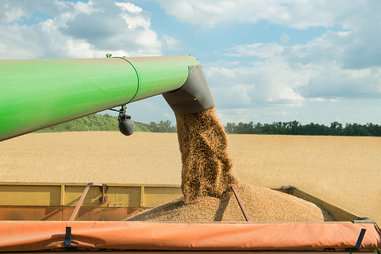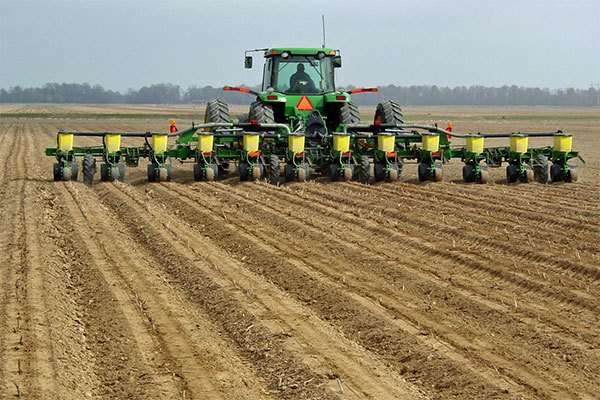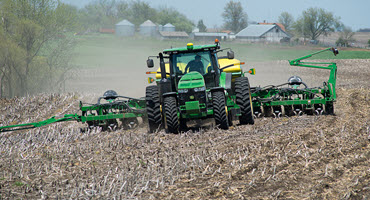Texas farmers have the most winter wheat harvested of any state
By Diego Flammini
Assistant Editor, North American Content
Farms.com
American producers are harvesting their winter wheat crop, according to the USDA’s latest Weekly Weather Crop Bulletin for the week of May 28 to June 3.
Nationally, only about 10 percent of the harvest is complete. That figure is up slightly from the five-year average of 7 percent.
Producers in Texas have harvested 58 percent of their winter wheat crop, the most of any state.

87 percent of the total U.S. winter wheat crop is headed, according to the USDA, down slightly from the 85 percent five-year average.
Arkansas, California, Illinois, Missouri, North Carolina, Oklahoma and Texas all report 100 percent of their crop headed.
Nationally, 42 percent of the winter wheat crop is rated as “good.”
Corn
Corn planting across the U.S. is 96 percent complete, according to the USDA. That number is only down 1 percent from the five-year average.
Growers in Minnesota, Missouri, North Carolina and North Dakota reported 99 percent of their crop is planted.
Farmers in Pennsylvania reported 82 percent of their crop planted. This figure is the lowest number of the 18 recorded states.

86 percent of the American corn crop has emerged, the USDA report says, only down 1 percent from the five-year average.
Minnesota, Tennessee, North Carolina and Nebraska all recorded more than 90 percent emergence.
Michigan recorded the lowest emergence at 66 percent, down from the five-year average of 80 percent.
And 58 percent of the American corn crop is rated as “good,” according to the USDA.
Farmers in Colorado and Pennsylvania reported over 70 percent of their crop as "good."
In Tennessee, farmers rated 27 percent of their crop as "excellent."
Soybeans
Across the U.S., farmers have planted 83 percent of the total soybean crop, the USDA report says, up from the five-year average of 79 percent.
Louisiana, Iowa, Minnesota, Missouri, Nebraska and South Dakota reported more than 90 percent of their respective crops planted.
North Carolina has the lowest recorded planting percentage at 57 percent. But that number is up slightly from its five-year average of 53 percent.
58 percent of the soybean crop has emerged, according to the USDA, down only 1 percent from the five-year average.

Louisiana reported 93 percent of its soybeans emerged, up from the five-year average of 84 percent.
On the other end of the scale, Wisconsin only reported 34 percent of its crop emerged, down from the five-year average of 53 percent.
Spring Wheat
On a national scale, 90 percent of the spring wheat crop has emerged, according to the USDA’s report. That number is up from the five-year average of 85 percent.
Minnesota and South Dakota report 100 percent emergence.
And 48 percent of the total spring wheat crop is rated as "good."
Fieldwork Days
The states with the most suitable fieldwork days during the week of May 28 to June 3 were:
- Arizona and Nevada – 7
- California and Utah – 6.9
- Oregon – 6.6
- Montana and South Dakota – 6.5
The states with the fewest number of suitable workdays were:
- Pennsylvania and Vermont – 3.5
- New York – 3.3
- Mississippi – 2.2
- Connecticut – 2
- Louisiana – 1.5
Weekly Precipitation Levels as of June 3
State | Precipitation (inches) | Weather Station |
Illinois | 1.31 | Rockford |
Indiana | 0.92 | Indianapolis |
Iowa | 0.02 | Cedar Rapids/Dubuque |
Kentucky | 0.16 | Jackson |
Michigan | 1.59 | Traverse City |
Missouri | 0.39 | St. Louis |
New York | 2.19 | Binghamton |
Ohio | 1.59 | Cleveland |
Pennsylvania | 2.01 | Williamsport |
Tennessee | 1.30 | Chattanooga |
The next Weekly Weather and Crop Bulletin is scheduled for release on Tuesday, June 13.